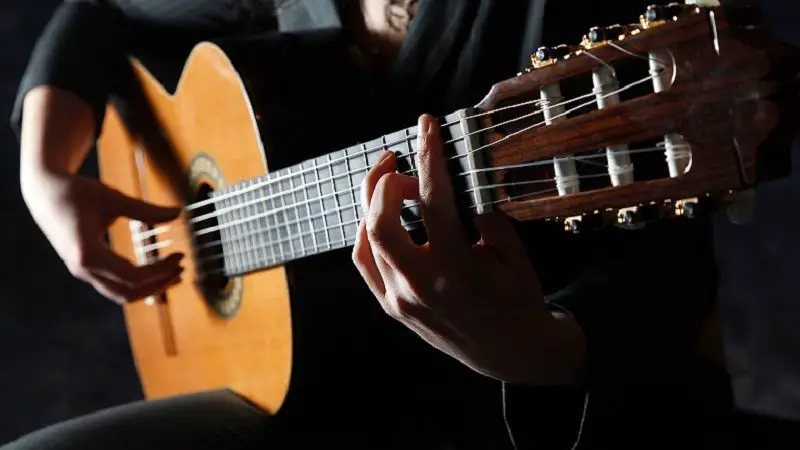
Here’s a complete guitar buying guide written for the first time guitar buyer, to help you choose the instrument that suits you best.
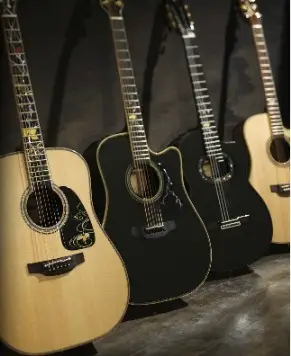 Whether you’re a first-time player, weekend warrior or seasoned professional, and no matter what your playing style is, KeytarHQ will help you find the right guitars, bass guitars, amps, effects and accessories for your needs.
Whether you’re a first-time player, weekend warrior or seasoned professional, and no matter what your playing style is, KeytarHQ will help you find the right guitars, bass guitars, amps, effects and accessories for your needs.
Whether you are looking for an electric guitar, bass guitar, acoustic guitar, guitar amp, synth, midi guitar, music accessories, we have all the information you need to make an informed decision. All in one place!
We also bring to you the best guitar lessons, and reviews of the best instructional tools for learning to play the guitar.
Various Guitar Types
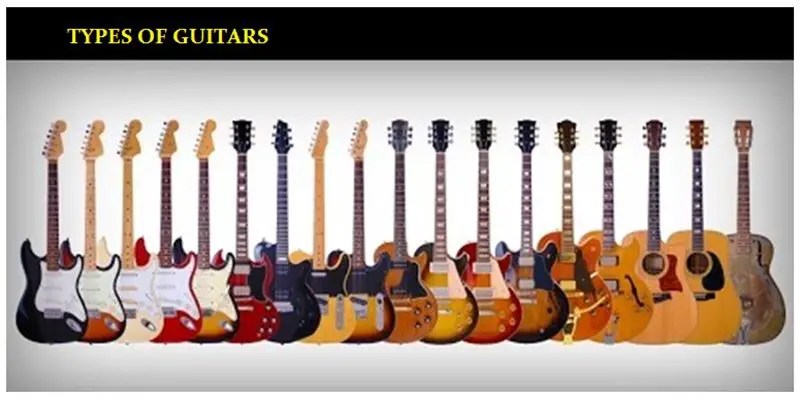
At the basic level, any guitar that you take is a plucked string instrument. Irrespective of the type, you play the guitar with either your fingers or using a pick. And even in terms of make, you will basically find that any guitar will have a body and a neck attached to it. The strings, usually six in numbers, run across the neck up to the body.
Acoustic Guitar
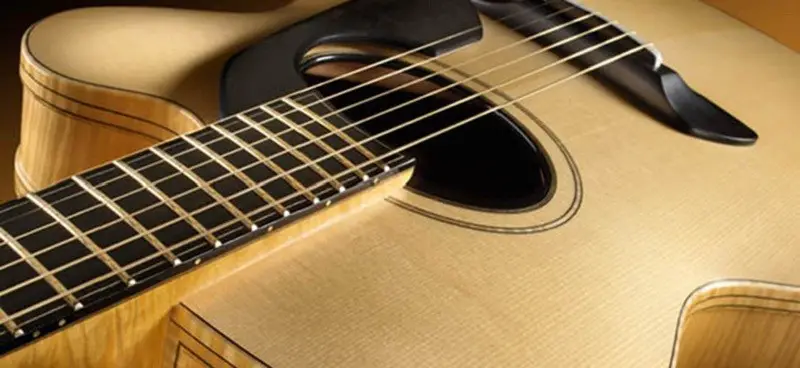 Acoustic guitars are generally made out of wood, and are dependent on their body shapes and structures to generate the sounds. The body of an acoustic guitar is large and hollow due to which the sound emanating from the strings is amplified when it comes from the sound chamber. The body style of an acoustic determines the tonal quality and sound projection.
Acoustic guitars are generally made out of wood, and are dependent on their body shapes and structures to generate the sounds. The body of an acoustic guitar is large and hollow due to which the sound emanating from the strings is amplified when it comes from the sound chamber. The body style of an acoustic determines the tonal quality and sound projection.
Unlike electric guitars, don’t need external devices to enhance sounds. The strings are usually made of steel or nylon.
An Acoustic Electric Guitar lets you play in both acoustic as well as electric mode.
Classical Guitar
 Classical guitar (also known as Spanish guitar) are acoustic guitars but have strings made of nylon. Due to its flat, wide neck, it makes it’s comparatively easier to play scales and some chord forms due to less interference from adjacent strings.
Classical guitar (also known as Spanish guitar) are acoustic guitars but have strings made of nylon. Due to its flat, wide neck, it makes it’s comparatively easier to play scales and some chord forms due to less interference from adjacent strings.
Classical guitars produce whole sounds which are very pleasing to the ear. Flamenco guitars are similar to classical guitar but produce crisper and thinner sounds.
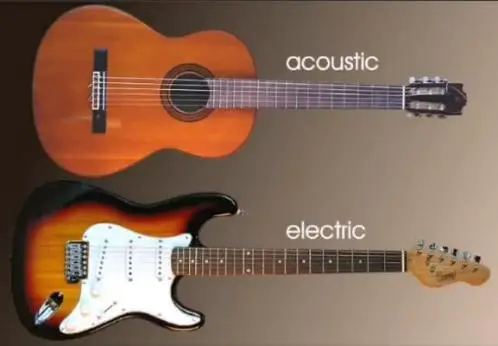
These are similar to the classical guitar, but have much more solid construction. The bodies are significantly larger than the classical guitars, and they produce a warmer tone than the classical guitar.
Twelve String Guitar
These guitars have twelve strings: six regular strings and six thinner strings. The second set of strings are tuned an octave higher, hence the strumming is loud with a depth of sound. It is a little hard to play and is a little more expensive than other guitars. However, these produce a semi-chorus effect which is very pleasant to the ears.
Electric Guitar
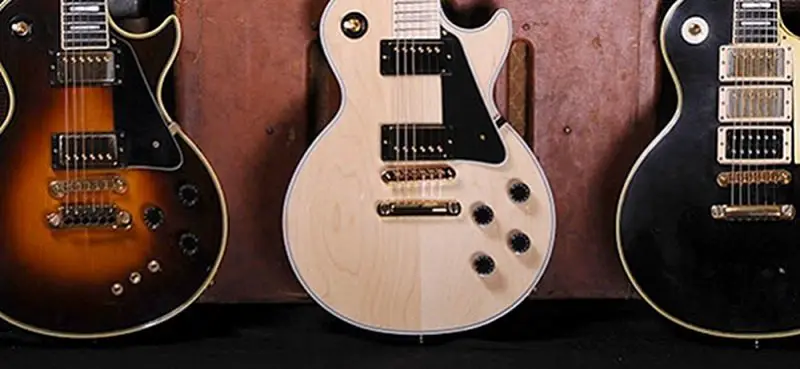 Electric guitars use electronic pick-ups to amplify the vibrations of the guitar strings. These pickups convert the energy of the strings into electrical impulses, which are then amplified using electric amplifiers. Unlike acoustic guitars, these don’t use the body for sound resonance, so if you play them without an amplifier, they will make little or no sound at all. Electric guitars come with multiple knobs that are used for changing the volume or the tone of the guitar.
Electric guitars use electronic pick-ups to amplify the vibrations of the guitar strings. These pickups convert the energy of the strings into electrical impulses, which are then amplified using electric amplifiers. Unlike acoustic guitars, these don’t use the body for sound resonance, so if you play them without an amplifier, they will make little or no sound at all. Electric guitars come with multiple knobs that are used for changing the volume or the tone of the guitar.
You get various types of electric guitars such as solid body, semi-acoustic, full hollow-body.
Hollow-bodied electric guitars produce fuller and woody tone, but are prone to feedback at high levels of amplification. Semi-Hollow body electric guitar is best when acoustic sound of the guitar is required with high level of amplification.
Musicians prefer semi-hollow guitars because they have their own type of resonance with good sustain, besides having less feedback issues.
Solid-body Guitars are best if you need loud amplification and lots of effects. Solid bodies offer greater sustain whereas the hollow bodies have a warmer tone.
Hollowbodies are more susceptible to feedback, these are used by experienced players who know how to handle the feedback problem using humbuckers, amp settings and effects processors.
Though more experienced guitarists may prefer the semi-hollow bodied guitars for their roaring sound, solid body guitars do have a different sound characteristic. And for that reason, most guitar players also have one as part of their music gear.
Guitar Pickups (pups)
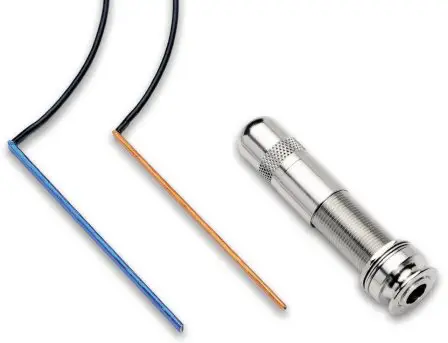 The better the quality of the pickups (aka pups), the better is the quality of the sound produced. There are different types of pickups, commonly used ones are: Magnetic pickups, Piezo electric pickups, Condenser pick ups.
The better the quality of the pickups (aka pups), the better is the quality of the sound produced. There are different types of pickups, commonly used ones are: Magnetic pickups, Piezo electric pickups, Condenser pick ups.
Piezo guitar pickups are placed under your bridge; Sound-hole pickups easily slip across your sound hole and can also be removed after the performance. You can use combination of different
Soundboard transducers are best for flatpicking, undersaddle transducers for finger style and sound hole pickups for other music like rock acoustic, solo performances and small venues.
Bass Guitar
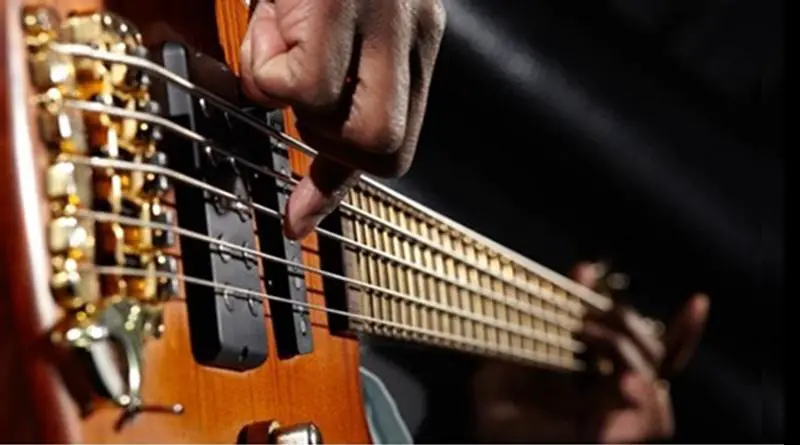 Bass guitars come with four or five strings, the strings are thicker and these guitars have a longer scale length. They are tuned just like the bottom four strings of the guitar but an octave lower.
Bass guitars come with four or five strings, the strings are thicker and these guitars have a longer scale length. They are tuned just like the bottom four strings of the guitar but an octave lower.
Bass Guitars are available as acoustic as a well as electric basses (and also as fretless). Fretless Bass guitars do not have any frets, and there are many bass players who love this instrument because of its unique tone, and also because its a bit easier to slide gracefully between the notes. The fretless bass may not be a great first bass choice for most beginning bass guitar players.
Guitar Parts
Every guitar has a few essential parts – the guitar neck with guitar nut and headstock, fret board, tuning keys, Guitar Bridge, sound box and guitar strings. Each of these parts play an important role in creating the overall sound.
Also Read: Parts of a Guitar.
Classical Guitar (Spanish Guitar) vs Acoustic Guitar
Both are acoustic instruments but the main difference is that acoustic uses steel-string whereas classical guitars use nylon string.
Nylon strings are thicker and produce mellower or softer sound. Steel strings produce a bright sound that resonates longer than a classical guitar.
Truss Rod
Because of the lower tension in nylon strings (compared to steel strings), classical guitars do not require a truss rod to compensate for the string tension.
Fret Board
Fret board of a classical guitar is much wider compared to the one on an acoustic guitar. Classical guitars usually don’t have the fret markers (dots or inlays) along the fingerboard.
The shape
Certain shapes/cuts available on acoustic guitars may not be available on classical guitars. Acoustic guitars mostly come in a dreadnought shape (considerably larger than that of a classical guitar). Cutaway design (that allows you to easily access the higher frets) are also rare on classical guitars.
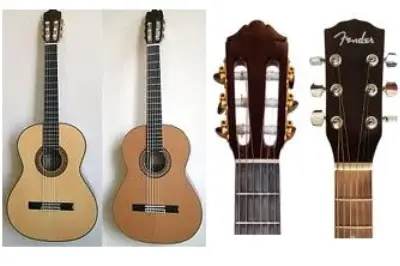
Most steel-string guitars have a higher action (compared to nylon-string classical guitars), which makes it slightly harder to press the strings down, which can result in sore fingertips.
A classical guitar is comparatively easier on the fingers, due to the nylon strings.
However, steel-strings produce a brighter and louder sound, and most kids would want to play on steel strings. Because Steel strings can be hard on the fingers of children, its important that the child get over the physical obstacle early on (by practicing frequently but for shorter duration). Kids should ideally practice for shorter duration every day before their fingers become ready to play for extended periods.
Kids can also play steel string guitars, its just that they will need to play for a few minutes each day so they can build up calluses on their finger-tips, after when they should be fine to play guitars with steel-strings. You may also consider nylon stringed (classical guitars) that are easier on the fingers.
Adults on the other hand will love the steel strings because of the bright/loud sound it produces.
Guitar players use classical guitars to play primarily finger-style (fingerpicking). The nylon strings make it easier to play finger-style on Spanish guitars.
Acoustic Guitar vs Electric Guitar
So which one is easier to play and which one should you start learning on?
First thing is that anyone who understands the basics of the fretboard should be able to play both – electric or acoustic. Most experienced guitar players own both, though they have their own preferences.
You cannot alter the sound of the Acoustic guitar much, probably a bit by changing the strings. However, you can do that with electric guitars.
An acoustic guitar is comparatively harder to play (physically) because of the relatively heavier gauge strings, the higher action and wider neck. An electric guitar is easier on the fingers because of their lower action and thinner neck.
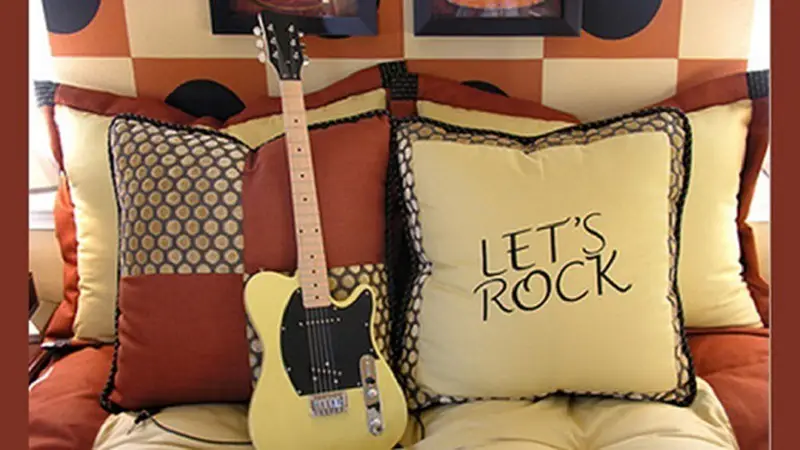
Most experienced guitar players and teachers suggest that you start on an acoustic guitar, which makes it easier to shift to other guitar types later on.
Guitar Construction
Guitar Parts: Structure of a Guitar
A guitar consists of a body and a neck, to which the strings are attached. Let us look at some of the important parts of the guitar in detail.
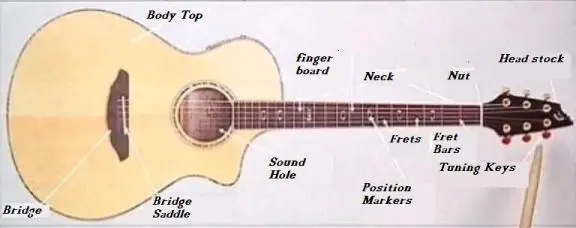
The neck holds the strings, tuners, nut, frets and fretboard. The neck is where you play all the notes (by fingering, tapping and other ways). The design of the neck has an impact on the play-ability of the guitar.
The neck of the guitar is usually either bolted or glued to its body. The neck part consists of frets, truss road, tuners, fret board and headstock which are all fastened to a long extension made of wood. Usually the wood on the neck and the fret board are always different from each other. You can determine the quality of the guitars quality by checking its firmness or stiffness.
The neck region of the guitar consists of the following parts:
- Headstock / Head: The headstock is located at the neck end of the guitar which is farthest from the body. It holds the tuning gears that the strings are attached to. The tuning gears, or tuning pegs as we alternatively call it, is used for tuning the guitar. The design of the head determines the placement and design of the tuners also.
- Nut: You will find the nut at the joint where the headstock meets the fretboard. The nut holds the strings in place on the neck.
It is a small strip made up of plastic, steel, brass, fossilized mammoth bone or other hard metals (bone is better). The nut is important for tuning of the guitar. It must be cut accurately; else it contributes to tuning problems due to string slippage or buzz.
- Fretboard: You will find the fretboard is usually made of rosewood and is glued to the neck of the guitar. Fretboard is a piece of wood which has many frets embedded in it and is also called as fingerboard. It is on the top of the neck of the guitar. In classical guitars, the fretboard is flat, whereas in acoustic and electrical guitars, the fretboard is slightly curved.
- Frets: Frets are metal strips, made of either nickel alloy or steel placed on the fretboard. It is placed in such a way that it divides the scale length on the basis of a specific mathematical formula.
The frets determine the tone, when you press the strings to the fingerboard between the frets or pluck or strum it, you get a tone.
The total number of frets on a guitar depends of the type of guitar (acoustic or electric), and to some extent on the model.
Acoustic guitars usually have around 19-20 frets. Electric guitars have around 22 to 24 frets. So, Most modern guitars have around 19 to 24 frets.
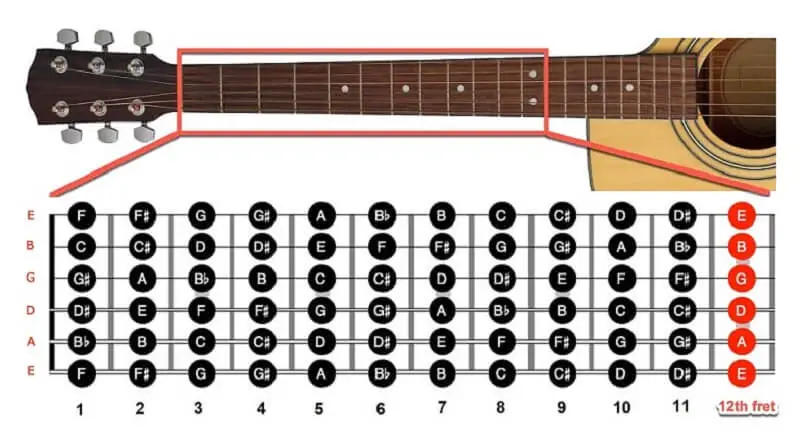
- Strings: All guitars have strings. Most guitars have 6 strings, but some have more. The more strings the more sonic possibilities. More expensive guitars use better wood and its top quality craftsmanship make a lot of difference to the sound quality.
Body
Be it any type of guitar, the resonance of the wood structure of the body affects the sound produced by the guitar.
Bridge
In an acoustic guitar, the bridge enables the transfer of vibration from the strings to the sound board causing a vibration inside the soundboard thus amplifying the sound produced by the strings. The bridge holds the strings in place on the body of the guitar.
The way the bridge is attached, affects the sustain (how long the notes sound) and sound quality of the guitar.
Pickups
Pickups help in amplifying the sound. Most guitars have at-least one and maximum of 3 pickups.
To make the sound of the guitar louder, acoustic guitar has a resonance chamber and the electric guitar has pickups.
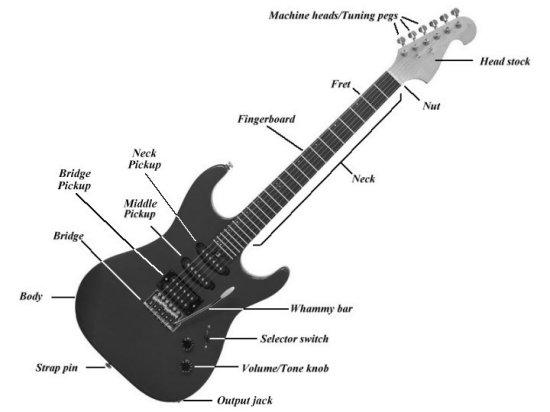
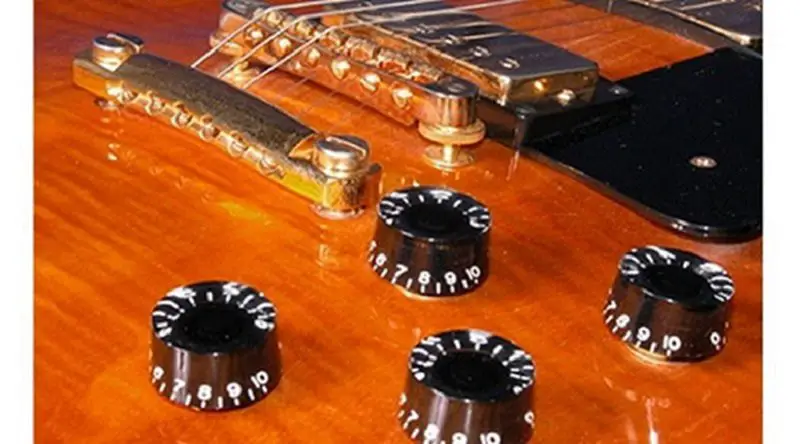 An electric guitar also has volume and tone control.
An electric guitar also has volume and tone control.
- Volume: Raises/lowers the volume
- Tone: Raises/lowers the treble. Most keep it turned up all the way.
You will also find a switch called the pickup selector. These are rectangular shaped things with dots on them, located underneath the strings on the body.
When the switch is turned toward the neck, then the neck pickup is selected(usually has a mellower tone). When it is facing toward the back of the guitar, then the bridge pickup is selected. Then one of the tone knobs adjusts the tone for one of the pickups and the other one adjusts it for the other.
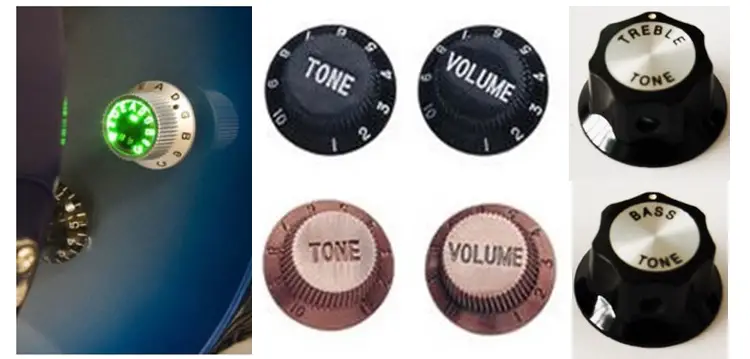
- Neck: Headstock, tuning machines, nut, fingerboard, frets, strings, back of the neck
- Body: Pickups, controls, bridge, strap pin, end pin, jack
- Innards (guts): Truss rod, electronics, batteries
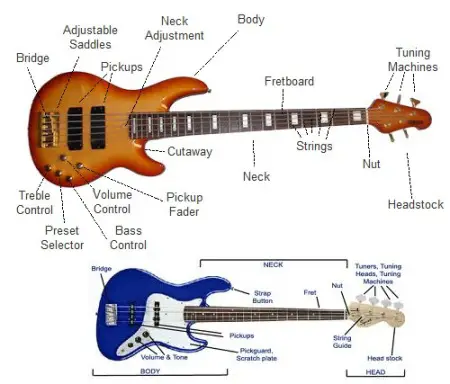
Various Guitar Sizes / Body Shapes
Here are the popular guitar shapes; we haven’t listed the exact dimensions because they can vary depending on the guitar manufacturer/maker.
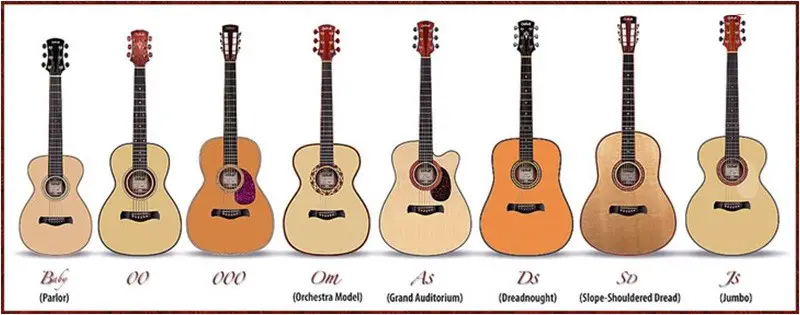
- Parlor Guitars
Smallest acoustic guitar body size. Preferred for fingerpicking. The have a light, yet balanced sound. - Concert, or Model “O”
“O” guitars are slightly larger in size and like parlor guitars, are balanced in tone and response and produces deep bass tones. Suited for fingerpicking. - Grand Concert, or Model “OO”
The Grand Concert is based on the shape of the classical guitar, and is one of the quietest acoustic guitars. Its sound is not as bright or balanced as the smaller models, and not as bassy or boomy as the larger sizes. It has a solid mid-range register.Like classical guitars, these produce clean, warmer sound. These are not harsh when played on the higher frequencies, but can produce a muddy sound when used for fast strumming. - Orchestra Model, Grand Auditorium, or Model “OM” or “GA”
This model is also sometimes called an Auditorium or “OOO”. It is a mid-size guitar, with great balance, volume, and projection. It has more presence than the smaller guitars mentioned above but lacks the heavy bass response of the larger guitars mentioned below. Use it for finger-style playing, or for solo gigs. - Dreadnought
This is the most common acoustic guitar shape. When people talk about guitars in western music, they usually mean this model. The dreadnought is a large-bodied guitar that has a lot of bass response. This guitar is a favorite among flat-pickers and is also great for accompanying vocals because of its full-sounding lower registers (support the voice well). - Jumbo and Super-Jumbo
Among the largest guitars you will find, often used for strumming because of their great bass response. Popular in country music.
Guitar Tops / Tonewood
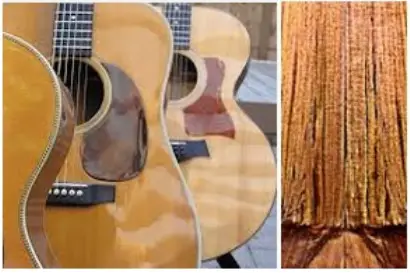
The guitar top determines the resonant qualities of the guitar and the tone it produces. Some of the more common materials used for tops include Laminate Top, Solid Spruce, Solid Mahogany, Solid Cedar.
As a beginner, you are most likely to start playing on a laminated top, as they are inexpensive. “Solid Wood” top is what experienced/pro guitar player use as they have a much better sound and tonal quality.
Solid tops ‘age’, the longer and more they’re played, the better they sound. Generally, older the wood, the better is the tonal quality.
Humidity affects most “Solid wood” (in the long run) and the wood can dry out and shrink; so if you live in a very humid area, you should consider getting a humidifier.
Guitar Bracing
Bracing helps to maintain the tonal responsiveness and structural integrity of the sound box. Bracing is used to better withstand the stress that is applied by the strings, with minimal distortion, while allowing the top of the guitar to respond as fully as possible to the tones generated by the strings.
Guitars tops are braced with an “X” pattern. In this style, an X intersection is formed behind the soundhole, at times with two or three additional transverse braces (often called “tone bars”) behind the bridge. Some guitar tops feature variations on standard X-bracing like scalloped or tapered bracing.
Guitar Action & Fret Buzz
Guitar action refers to string height above the fingerboard; it influences the ease with which you can play and determines how easy a guitar’s strings are to fret. Fortunately, you can adjust the action to suit your needs.
Though this is more of a personal taste and may vary from player to player, a High action (strings are higher) usually is difficult to play, whereas a lower action is much easier to play. But then high-action makes the guitar sound buzz-free and also gives a higher volume. Lower action (strings are closer to the fingerboard), on the other hand, is prone to buzzes, especially if you play aggressively. Most experienced players make a compromise between the two.
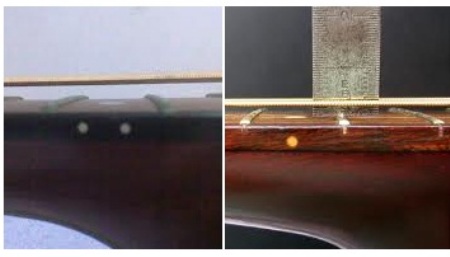
Fret buzz is the sound caused by a guitar string rattling/buzzing against a fret wire when the guitar string is plucked or played. To eliminate Guitar Fret Buzz, you may try raising the bridge slightly. At times, fret buzz is caused because of the players’ technique and not because of the guitar. If the plays the strings too aggressively on a perfectly fine guitar, fret buzz may still occur.
To raise or lower strings, you can adjust the “saddle” of each string. Turn the screws in one direction and the string lowers, do it the other direction and the string raises.
Guitar Tuning
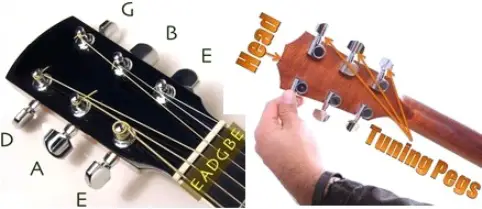 Guitars tend to go out of tune quickly, especially if it’s a budget one. Tuning and changing the strings are common maintenance activities associated with any stringed instruments. You can use the standard tuning which is universally accepted all across the world today to tune your guitar. To tune a guitar, the strings will need to be tuned to the following notes:
Guitars tend to go out of tune quickly, especially if it’s a budget one. Tuning and changing the strings are common maintenance activities associated with any stringed instruments. You can use the standard tuning which is universally accepted all across the world today to tune your guitar. To tune a guitar, the strings will need to be tuned to the following notes:
- E – the thickest and lowest sounding string is known as the 6th string
- A – the 5th string
- D – the 4th string
- G – the 3rd string
- B – the 2nd string
- E – the thinnest sounding string is known as the 1st string
Before you start tuning, you need a reference pitch from some other source such as some other guitar, piano or even a tuning fork etc. Once the reference pitch is set, tuning the guitar can be done based on that note.
An electronic tuner can save yourself all the hassle and you can get it for less than 10 bucks nowadays. You can even use online guitar tuners which are freely available for use.
Some tuners even clip-on to the guitar so it is always there in case you want to adjust the tuning of any string/s.
Guitar Intonation refers to accuracy of the pitch, the extent to which the notes produced are in tune, versus being flat or sharp. In simple term, it is about tuning the guitar right from one end to the other. Usually on guitars, most of the notes are set correctly but over time, as you move up the fret-board you will notice that some of the notes start become sharp or flat.
It is quite easy to check the intonation using an electric tuner.
You must change your guitar strings from time to time as strings go dull and listless over time, though there is no fixed rule as to when you should change them. It depends purely on your usage of the guitar. Usually, a set of strings lasts for about 3 months or so.
How to Change Strings on a Guitar.
Tools Needed for Guitar Setup an Maintenance
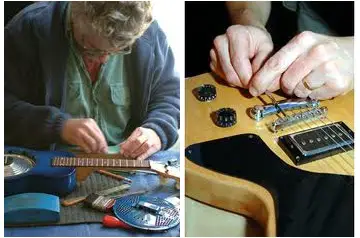 Guitars need proper care so that it continues to play beautifully, retain their finish, and last longer.
Guitars need proper care so that it continues to play beautifully, retain their finish, and last longer.
Here are some tips and tools related to guitar setup and maintenance.
You can use a good furniture polish to clean your guitar. You can also use toothbrush and soap water to clean any oil, grime and dust build up from the guitar; avoid wiping the strings with wet cloth.
Keep it away from extreme weather such as heat, moisture, cold, too much humidity, as it may damage the guitar. Keep your guitar in a case when not in use.
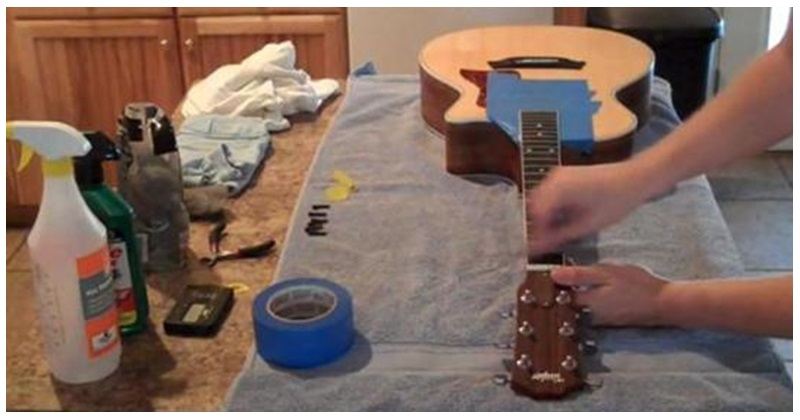
Tools needed for setup: Screwdriver, Allen keys, and a chromatic tuner.
You can also buy a guitar setup tool kit that includes commonly used tools such as screwdrivers, hex wrenches, diagonal cutter, string winder, ruler and more. You can do setups, adjustments, to ensure your guitar is operating at peak levels.
Guitar Spares and Replacement Parts
Every guitar, be it acoustic or electric have more or less the same parts.
Guitars & Amps have the following parts:
Guitar Parts
This include the body, neck, tuning machines, bridge, and other hardware parts
Guitar Electronics
This comprises of pickups, controls, active electronics, connectors
Amplifier Parts
This consists of tubes, transistors, controls, speakers
You will find a huge selection of Guitar Parts now available for you to buy online: replacement control knobs, Guitar Nuts, bridge pins, saddles, jack plates, pickups.
Guitar Saddles
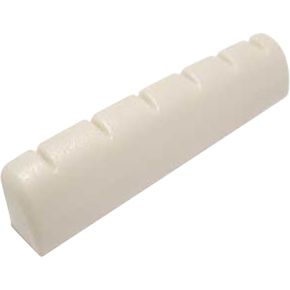 You can now buy from an array of saddles and tailpieces for electric, acoustic and bass guitars.
You can now buy from an array of saddles and tailpieces for electric, acoustic and bass guitars.
Please note that the acoustic saddles often come slightly over-sized so that you can sand it down to a perfect fit. This doesn’t take very long and it’s a relatively easy job.
Guitar Bridges, Pins & Bridge Parts
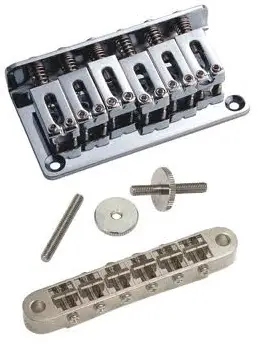
Bridges also play an important role in how the guitar looks; the overall finish of the guitar (especially in classical guitars).
Usually, Bridges are made of a single piece of material (mostly wood), that fits between the strings and the resonant surface. However, it may also be made of multiple parts.
The job of the bridge pin is to hold the string in place at the bridge. Depending on the material used, these can increase sustain, give you more clarity, and even a better overall volume.
Bridges for electric guitars are categorized as “vibrato” and “non-vibrato” (aka hard-tail).
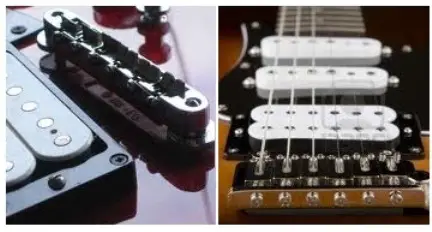
Non-vibrato bridges supply an anchoring point for the strings but provide no active control over string tension or pitch. These guitars have more reverb in their sound, because of the string resonance behind the bridge.
It is seen that generally a non-tremolo bridge provides better tuning stability and also a solid contact between the guitar body and the strings.
Please note that some prefer to use the word Tremolo or Vibrato.
Types of Bridge Pins
- Fluted bridge pins have a groove cut in them which provides room for the string to pass between the pin and bridge.
- Solid bridge pins require notches in the bridge to accommodate for the strings diameter.
Commonly used materials for Bridge Pins include: Wood, Bone, Plastic, Metal. The most common ones (and among the least expensive) are the plastic pins.
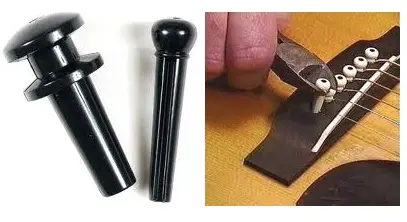
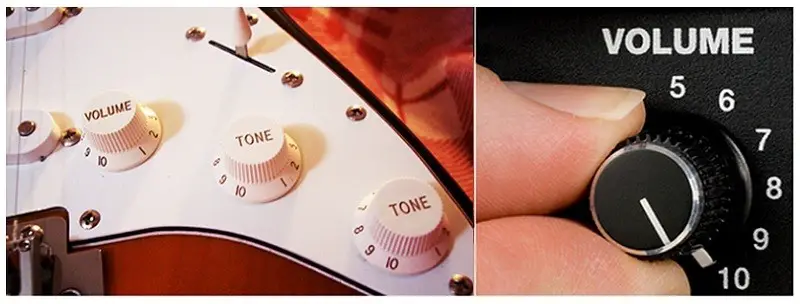
Guitar Reviews
Best Acoustic Guitars for Beginners & Hobbyists
Donner DAG-1C: Full Size cutaway guitar. Affordable kit with useful accessories
Best Choice products Guitar Kit: Nice, affordable starter kit that offers value for money
Full length acoustic guitar with steel strings for aspiring musicians. All-wood body, synthetic wood fretboard, produces a bright sound. This kit includes a pick, digital tuner, pitch pipe, shoulder strap, an extra set of strings, and nylon case. Best Choice Products is a leading manufacturer of children’s products, though this guitar is not a toy but a real full-length guitar. This is a great affordable guitar with a great sound.
Epiphone DR-100: Well-made acoustic guitar with a warm tone
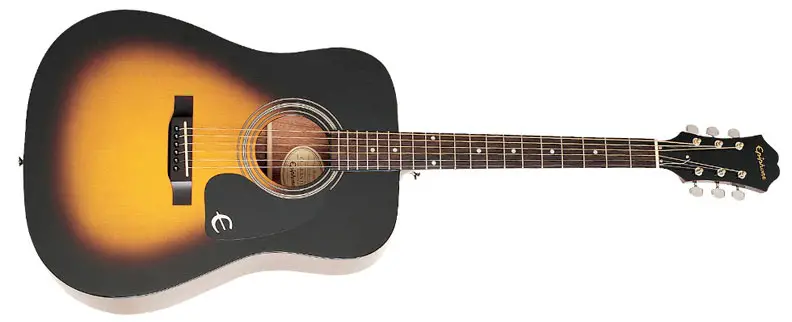 The Epiphone DR-100 offers fantastic value and is a good acoustic guitar for beginners to start learning. With Spruce top, Mahogany body/neck, and rosewood fingerboard, its also elegantly designed and is available in three distinct finishes. You can use it to play pop, bluegrass, folk, rock, country, and everything in-between.
The Epiphone DR-100 offers fantastic value and is a good acoustic guitar for beginners to start learning. With Spruce top, Mahogany body/neck, and rosewood fingerboard, its also elegantly designed and is available in three distinct finishes. You can use it to play pop, bluegrass, folk, rock, country, and everything in-between.
The Epiphone DR-100 is easy-to-play, is lightweight, the body is relatively smaller compared to most acoustic guitars.
Martin Backpack Travel Guitar: Lightweight design
Martin Steel String Backpacker Travel Guitar with bag. Features a Solid Spruce Top, Solid Tonewood Back and Sides, Unique Contour Neck Shape, Features 24-Inch Scale Length, Features 15 Frets.
Best Electric Guitars for Beginners and Hobbyists (for under $200)
At this price point, you will find guitars that are actually better than ‘beginner guitars’, but they are also not guitars for the intermediate players – these are somewhere in between.
You might also need extra set of guitar strings, some extra picks, tuner, and probably some beginner books when you buy a Beginner Electric Guitar.
Yamaha PAC112V Pacifica Electric Guitar
The Yamaha Pacifica PAC112V is one of the more popular electric guitar models, its a more affordable first guitar and has a nice, bright sound with good sustain.
The Yamaha PAC012 Pacifica guitar has been around for several years, and is one of the best value-for-money electric guitars, that provides quality workmanship and great playability at a price that most beginners & intermediate level players cannot resist.
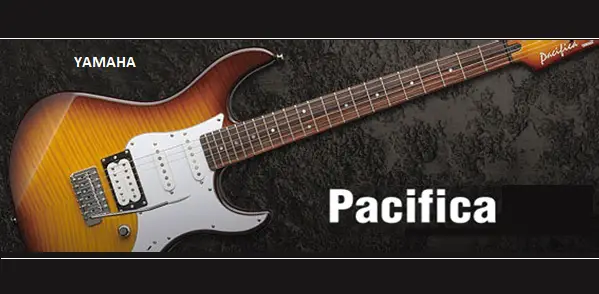
Buy on Amazon.
Yamaha Gigmaker EG Electric Guitar Pack
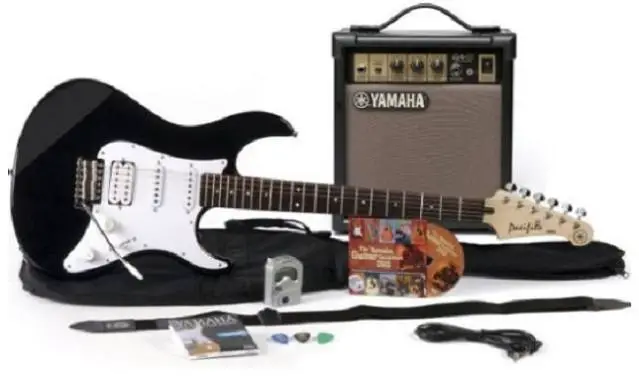
Classical Guitars Reviews

Most beginners usually start off with a classical (nylon-string) guitar because of the nylon strings (easier on the fingers). High-end classical guitars on the other hand are used by experienced players to play in the classical or flamenco style.
There are several options around the 300 dollar mark that are of good quality. But these are definitely not going to sound like a 1000 dollar guitar. A quality instrument inspires the player to practice more and become better as a musician. So, serious players should consider buying the best solid top guitar you can afford.
Here are reviews of some of the best Classical Guitars (nylon strings) available from different brands and for various prices.
Full Size
- Yamaha FG840 Nylon-string Acoustic Guitar
- Kremona Right Handed (S65C) Classical Guitar
- Cordoba C9 CD/MH Nylon String Classical Guitar
- Pumping Nylon: The Classical Guitarist’s Technique Handbook: This is a masterpiece book for developing the correct technique for both left and right hands.
Related Posts:
KeytarHQ editorial team includes musicians who write and review products for pianists, keyboardists, guitarists & other musicians. KeytarHQ is the best online resource for information on keyboards, pianos, synths, keytars, guitars and music gear for musicians of all abilities, ages and interests.



Leave a Reply